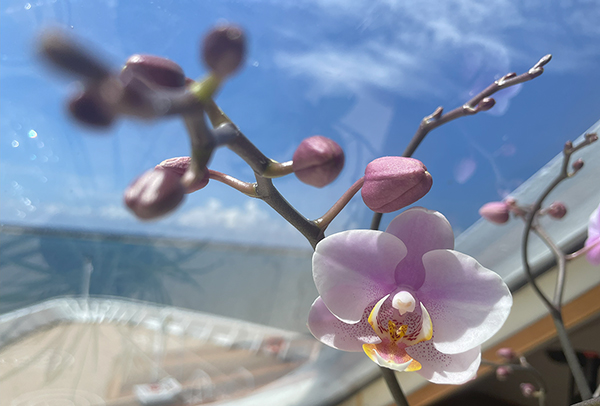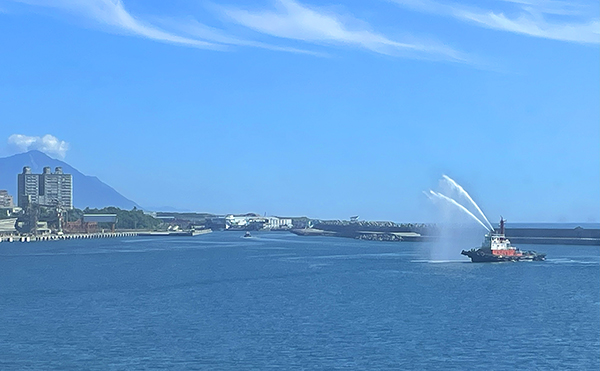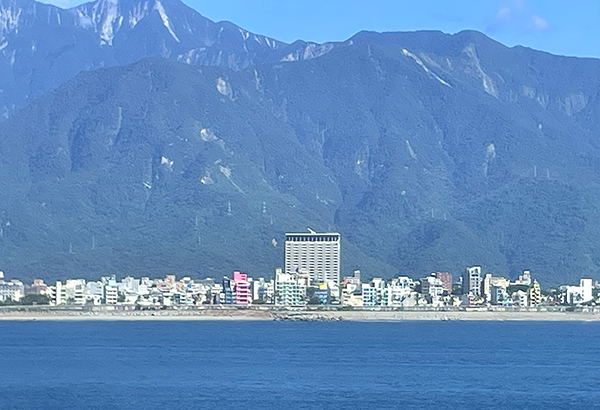

|
|
 |
 |
 |
|
September 15-18, 2025 Marti Eicholz Cruising from Hualien to Taipei, Taiwan, the Odyssey follows Taiwan’s eastern coast, a relatively short trip. The eastern coastline of Taiwan is known for its scenic beauty, being picturesque, but we are sleeping, preparing for our arrival. Taiwan is a semi-tropical island in East Asia. Like many other places in Asia, Taiwan is densely populated and highly developed in terms of economics, technology, and transportation, also a political and cultural center. It is a modern cosmopolitan metropolis, exciting, lively, and rapidly changing. Its people are highly educated and well-traveled. As the Odyssey approaches the historic port in the greater Taipei area, meaning Keelung Harbor, located fifteen miles to the northeast of Taipei, as there isn't a port directly in Taipei city, we view a vibrant port city where a rich maritime history meets a modern, energetic atmosphere. Keelung is Taiwan's largest port city, a part of the Taipei-Keelung metropolitan area with neighboring New Taipei City and Taipei, on the northeastern coast, surrounded by mountains and scenic coastal views, a main gateway for cruise ships and goods entering the island. It's known as "Rainy Port," or “Rainy City,” famous for its drizzle and frequent heavy rainfall. Zhengbin Fishing Harbor in Keelung, Taiwan, is visually vibrant and culturally rich, starting with the sight of sixteen bright, rainbow-hued houses lining the waterfront which creates a picturesque, almost dreamlike scene. You feel the lively yet relaxed atmosphere of this historic, active fishing harbor, originally built in 1934. You can stroll along the waterfront, take in the stunning views of the fishing boats and the ocean, and explore local eateries offering delicacies like charcoal-grilled fish cakes. The port also serves as a gateway to the Keelung City Indigenous Cultural Hall and nearby Heping Island Park. Experiencing the Keelung City Indigenous Cultural Hall involves exploring its 5-story building which houses an exhibition hall on the 3rd and 4th floors highlighting the artifacts and daily lives of Indigenous peoples. You can also see traditional Amis cultural elements and other Indigenous relics. On the top floor, you'll find the Indigenous Culture Square with sculptures, stone slab houses, and a viewing platform overlooking Keelung Harbor. The first floor also features an activity center, and the overall environment offers a chance to learn about the history and traditions of Taiwan's diverse Indigenous communities. Heping Island Park, a nature park in Keelung, known for its distinctive coastal geological features, offers a unique experience with its stunning geological formations. You can hike an easy-to-navigate paved path, circling the island with breathtaking views of the Pacific Ocean. You can also explore other attractions on Heping Island, such as Fude Temple and Tianxian Palace. Fude Temple, a historic site, established on an official road to worship the Earth God. Keelung's Tianxian Palace is a majestic temple dedicated to Emperor Wu Xian, perched on the hills of Heping Island with panoramic views, overlooking Keelung Port, featuring a majestic, solemn atmosphere with spacious grounds, adorned with lifelike statues of the "Five Hundred Arhats" that surround the palace. Discover a hidden gem, nestled by the ocean in a serene environment, Chaojing Park, a captivating destination offering natural beauty with stunning views, rich marine life, cultural significance. A unique blend of natural splendor with urban charm. Keelung Miaokou Night Market offers a fantastic culinary experience. As a coastal city, Keelung excels in fresh seafood, including dishes like butter crab, grilled octopus, and fish cakes. You'll find unique items such as fried milk, which are crispy, creamy cubes of deep-fried milk, and classic Taiwanese fare like oyster omelets and bowls of thick bean-sprout soup. The market comes alive in the evening with street vendors, lights, and a bustling crowd. While Miaokou Night Market is known for food, claw machines feature unique prizes like snacks, home goods, and even food items that can be exchanged for food at the market itself, unlike typical toy-filled machines elsewhere. Many such arcades are clustered together, offering an exciting and creative experience. I have no idea how this game is supposed to be played. Hidden behind a railway line is a secret passageway, a tunnel, built in 1903 by the Japanese and now called the “100-Year Bomb Shelter,” a portal into the city’s underbelly, a refuge for those seeking shelter during World War II from bombs being dropped by American forces. Now it is a quirky pedestrian shortcut for locals, entering from one neighborhood and popping out in another. The bright-orange, crane-shaped Keelung Tower, a striking addition to the city’s skyline, offers panoramic views and highlights the city’s maritime identity. Beneath the observation deck is a thoughtfully designed bookstore, inviting you to relax and enjoy the view. Keelung is fourteen miles from Taipei as the crow flies; the train or bus takes around 45 minutes. Since we are not crows, we opt for the train. Taipei sits within a bowl-shaped basin in the northern part of Taiwan, which is a mountainous island. The Tamsui and Xindian Rivers, two of the island's main rivers, flow through the city. The city is encircled by mountains, including Qixing Mountain, which reaches a significant height within the basin's perimeter. Taipei has a humid subtropical climate and the summers are hot, muggy, and wet. It is hot and muggy and wet from the sweat. Pacific typhoons can occur this time of year. The city, home to some of the world’s tallest buildings, is defined by its modern skyline, featuring iconic structures like Taipei 101, a mixed-use skyscraper, 1,667 feet tall, 101 floors, plus five underground levels, known for its innovative design and structural stability, featuring a massive, tuned mass damper to counteract wind and earthquakes. Inspired by bamboo and pagodas, the tower includes restaurants, office space, a luxury shopping mall, and public observatories offering panoramic city views. It’s one of the best cities in the world for arts and culture. One hundred thirty-one museums and 198 art galleries dot the city. The National Palace Museum in Taipei, Taiwan, houses one of the world's most extensive collections of Chinese art and artifacts, spanning thousands of years and many dynasties. The collection, a treasure trove with 700,000 pieces, includes paintings, ceramics, jade, bronze, rare books, and documents, with the core coming from China's imperial collections, holdings representing nearly 5,000 years of Chinese history, from the Song dynasty to the present day. The museum, built in a classical Chinese architectural style with hipped roofs and turquoise and yellow roof tiles, opened in 1965 and features continually rotating exhibits to prevent wear on the collection. The museum complex also includes beautiful gardens and offers various food and drink options, including a traditional teahouse and a fine Chinese restaurant. Taipei is a hub for cultural heritage, blending Chinese, Austronesian, Japanese, and Western influences. Because Taiwan never experienced Communist oppression, we can witness traditional religious practices and ancient customs that disappeared from Chinese mainland. Taipei boasts one of the best bike-share programs in the world with a large network of bicycle rental kiosks. Renting is simple and cheap. Taipei is incredibly clean. The domestic rubbish disposal system is famous. The people believe trash should not touch the ground, so you put rubbish directly into the sanitation truck as it strolls by, playing Beethoven’s “Fur Elise” from loudspeakers. Taipei is home to important historical sites like the Chiang Kai-shek Memorial Hall and the ancient Longshan Temple which have survived significant historical events. Taipei is wealthy. More than 1,519 residents have a minimum of $30 million in assets, owning an average of 5.4 homes each, not being keen to display their wealth, its nicknamed ‘Asia’s stealthy rich country’. Taipei has a vibrant LGBTQ+ community, around the Ximending district's Red House. You can visit the ‘road to heaven.’ Xinsheng Road is nicknamed ‘Road to Heaven’ because of the high concentration of temples, shrines, churches and mosques lining the street. Traditional industrial spaces like the old tobacco factory buildings have been transformed into a vibrant cultural hub, such as the Songshan Cultural and Creative Park, a dynamic approach to urban development. A thriving space for art exhibitions, galleries, design studios, creative markets, boutiques, cultural events, and an ecological landscape pond, the Baroque Garden. Its mission is to foster originality and support young artists. The whole estate with its long hallways, its courtyards and its side buildings give an opportunity to explore the creative side of Taipei. What I love about Taiwan is how it breathes new life into its historic buildings, preserving their original character while seamlessly integrating modern design and technology. Taiwan does not demolish. It rebuilds. It revitalizes. It gives spaces a second life. Taipei is famous for its bustling night markets, hubs that operate from late afternoon to midnight, offering a vibrant mix of incredible food, entertainment, and shopping. You experience a sensory feast of incredible smells, interesting sights, and energetic crowds within areas characterized by "controlled chaos" and a lively atmosphere, an aromatic atmosphere, air filled with the enticing aromas of various dishes, sounds of hawkers, fast-paced music, and bustling crowds. In addition to food like the iconic xiaochi, or "small eats", from stinky tofu and oyster vermicelli to pork pepper buns and candied fruit, you find stalls selling clothing, electronics, beauty products, and souvenirs. Many markets also feature fairground-style games. Venture into the smaller alleys and side streets to discover hidden culinary gems and unique finds. The markets offer a unique window into local culture, with a palpable pulse and a tangible energy that captures the culinary identity of the city. Taipei evokes feelings of excitement and constant discovery due to its vibrant atmosphere, incredible food scene, and efficient public transportation. You could feel overwhelmed by the city's dynamism. Overall, the experience is one of vibrancy and boundless opportunity, where you can immerse yourself in a rich cultural landscape filled with friendly locals, modern marvels, and historical sites. Taipei is special for its unique blend of modernity and tradition, evident in its towering skyscrapers and ancient temples, alongside its vibrant night market culture offering world-renowned cuisine. The city is also distinguished by its significant collections of Chinese art, its friendly and safe environment with progressive social values. It is time to leave Taipei. The Odyssey is ready. Me and my shipmates will remember Taipei as a city with a fast-paced lifestyle, constant activity, making one feel alive and engaged with always something new to do, see, or taste. After a at sea, we will be ready for something new to do, see, and taste. |
|
Copyright © 2025 All rights reserved |